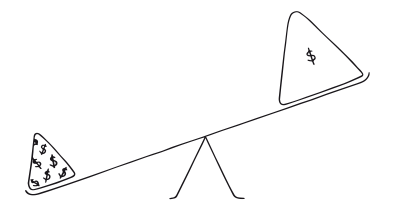Persuasive Patterns: Influence
Value Attribution
The perceived value of things increases with their cost and appearance

Value attribution refers to the tendency to perceive items as more valuable when they are associated with a higher cost or an upscale appearance.
If a store placed two identical bottles of wine side by side, but one was priced significantly higher than the other – then despite the similarity in content, customers would more likely perceive the higher-priced bottle as being of superior quality. This perception isn’t based on the actual taste of the wine, which they haven’t experienced yet, but on the price and presentation. The expensive-looking label and the higher price tag contribute to the belief that the wine must be better, leading customers to value it more and often choose it over the cheaper option.
Imagine that you were browsing for video courses on an e-learning platform and two courses caught your eye – both covering similar topics. The first course is titled “Introduction to Digital Marketing: A Comprehensive Guide,” priced at $50. The second is named “Elite Digital Marketing Tactics: Mastering the Market,” with a price tag of $200. Despite the courses’ content being largely the same, the second course’s title suggests a more exclusive and advanced level of knowledge, coupled with a higher price that implies a more valuable offering.
The study: the influence of price on taste perception
In 2008, researchers at the California Institute of Technology and Stanford University conducted a study demonstrating the influence of price on individuals’ enjoyment of wine. Participants’ brains showed more pleasure when they drank wine they were told was expensive, even though all samples were the same wine. This study compellingly illustrates the power of value attribution in shaping not just consumer perception, but their actual experience.
Researchers used functional magnetic resonance imaging (fMRI) to observe changes in brain activity when subjects tasted wines they were told were either expensive or cheap. The wines presented to the participants were actually the same wine, but the price tags were manipulated.
The findings were quite revealing. When participants consumed what they believed to be a more expensive wine, their brain activity showed more pleasure than when they drank the same wine presented as cheaper. Specifically, the medial orbitofrontal cortex, an area of the brain associated with pleasure and reward, was more active when the wine was presented with a higher price tag.
Plassmann, H., O’Doherty, J., Shiv, B., & Rangel, A. (2008). Marketing actions can modulate neural representations of experienced pleasantness. Proceedings of the National Academy of Sciences, 105(3), 1050-1054.
Value attribution operates on the assumption that expensive items or those with an appealing aesthetic are of higher quality. This pattern leverages the belief that cost and appearance are reliable indicators of worth, influencing how much a consumer is willing to pay or how they perceive the value of a product or service.
It can shape decisions and behaviors, especially in markets where the quality is difficult to assess directly, such as art or wine. This perception can be manipulated to increase conversions, establish brand prestige, and foster loyalty by aligning price points and product design with the intended value perception.
The principle of Value Attribution suggests that people’s assessment of an item’s value is not always a reflection of its objective utility or quality, but rather the subjective and sometimes arbitrary qualities attributed to it. A higher price tag or an elegant appearance can lead to the perception that an item is of higher quality, even if the intrinsic qualities are identical to a cheaper or less aesthetically pleasing counterpart. This is not solely because the individual believes that ‘more expensive means better,’ but also because of the social and cultural connotations associated with higher-priced or well-presented goods.
This principle is also intertwined with concepts such as perceived value and expected utility. For example, in a commercial setting, if a product is packaged attractively and presented as a premium offering, customers are more likely to believe it possesses superior qualities and thus attribute higher value to it. Similarly, in social contexts, the principle of value attribution can be seen when individuals attribute greater competence or status to people based on their appearance or the perceived quality of their possessions.
Value attribution significantly impacts marketing, branding, and product design, as it guides companies in shaping consumer perceptions. Through careful control of pricing strategies, branding, and product presentation, businesses can influence the attributed value of their offerings, leading to greater customer interest and willingness to purchase.
Value Attribution is a cognitive process that intertwines with several psychological phenomena:
- Anchoring effect
This is a form of cognitive bias where individuals rely too heavily on the first piece of information they see (the “anchor”) when making decisions. In the context of value attribution, if the first price a person sees for an item is high, they may anchor to that price and perceive the item as more valuable, even if subsequent prices are lower. - Confirmation bias
People have a tendency to search for, interpret, favor, and recall information in a way that confirms or supports their prior beliefs or values. Value attribution can be influenced by confirmation bias when an individual’s existing belief about the worth of a brand or product causes them to perceive its value as higher or lower. - Heuristic processing
Heuristics are mental shortcuts that ease the cognitive load of making decisions. Value attribution often involves heuristic processing, as individuals rely on simple cues (like price or brand reputation) to quickly assess value, rather than engaging in a detailed analysis. - Social Proof and Status
The perceived value of an item can be greatly influenced by its association with status or social proof. If an object is seen being used by people considered to be of high status or as part of an aspirational lifestyle, it may be attributed greater value by others who wish to emulate that status.
Designing products with Value Attribution
Integrating value attribution into product design requires an in-depth understanding of how customers perceive and derive value from both physical products and service experiences. To enrich the practical application of the value attribution pattern in product design, we can draw insights from service design and research on user interaction.
In service design, as noted by Yrjölä et al. (2019), shifting focus from simply delivering attributes to understanding and enhancing customers’ perceptions of value resulting from these attributes can greatly enhance the overall experience. For example, in the context of restaurants, it’s not only the quality of food that matters but also the ambiance, the service, and even the narrative behind the dishes that contribute to the customer’s perceived value. Designers can apply this principle by creating a holistic service environment that aligns with the desired value perception, ensuring that every aspect of the service, from the environment to the interaction with staff, reinforces the value narrative.
Similarly, in product design, the integration of users’ attribution of meaning into the design process is pivotal. Boess & Kanis (2008) highlight the importance of understanding how users attribute meaning to their interactions with products. This could mean designing products that not only serve a functional purpose but also resonate on an emotional level, aligning with the users’ self-image and values. For instance, a smartphone isn’t just a communication device; for many users, it’s a statement of personal style, a work tool, and a gateway to their social world. By understanding and designing for these layers of meaning, designers can enhance the product’s perceived value.
Thus, incorporating these insights into product design begins with a deep empathy for the user. Designers should engage in active research to understand the contexts in which a product will be used and the meanings users are likely to attribute to it. Design decisions, from form to function and beyond, should be informed by this understanding. The goal is to craft experiences where the product’s attributes are not just experienced but are perceived as valuable parts of the user’s life.
Moreover, by considering the service aspect, designers should create a narrative around the product that extends into the user experience, ensuring that every touchpoint — from marketing to after-sales service — reinforces the perceived value and meaning of the product. This could involve storytelling elements in marketing communications, packaging that reflects the product’s premium nature, or customer service that emphasizes the product’s reliability and the company’s commitment to quality.
Ethical recommendations
There is a risk that consumers, particularly those who are less price-sensitive, may perceive an unfair advantage being taken if pricing strategies are not transparent. This perception of dishonesty in price communication can significantly influence their intention to shop and erode trust in the brand (Zielke, 2014).
Avoid using pricing or marketing tactics that may be seen as manipulative. This includes hiding costs, presenting false discounts, or using deceptive pricing structures that can mislead consumers about the true value they are receiving.
Ensure that the value proposition is equitable and delivers real benefits to the consumer. Any claims about the product or service should be substantiated, and the actual value provided should match or exceed the consumer’s expectations based on the price paid.
The misuse of value attribution in design or marketing can lead to situations where consumers are misled about the intrinsic worth of products or services. A common example is when an item is presented as more luxurious or superior solely due to higher pricing or enhanced aesthetics, without any substantial improvement in quality or functionality. This can result in consumers making purchases that are not in their best interest, potentially leading to financial strain or buyer’s remorse when the perceived value does not match the actual experience.
To ensure ethical use of value attribution, designers and marketers should adhere to the following best practices:
- Transparency
Clearly communicate the actual features and benefits of a product, avoiding exaggerated claims about its worth that cannot be substantiated. - Fair comparison
When comparing products, ensure that comparisons are fair and based on equivalent criteria, providing consumers with a realistic understanding of value propositions. - Social responsibility
Consider the broader social impact of value attribution practices. Ensure that they do not reinforce harmful stereotypes or lead to socio-economic discrimination. - Regulatory compliance
Adhere strictly to all relevant consumer protection laws and guidelines regarding pricing, advertising, and marketing. - Price justification
When pricing is premium, justify it with enhancements in product durability, after-sales support, customer service, or contributions to social causes. - Avoiding exploitation of vulnerabilities
Do not exploit consumer vulnerabilities, such as financial insecurities or lack of knowledge, to sell higher-priced items under the guise of increased value. - Value co-creation
Involve consumers in the product development process, enabling them to contribute to the value creation of the products they buy.
Real life Value Attribution examples
Rolex
Their watches are not only priced to reflect their craftsmanship but are also presented in a way that emphasizes luxury, heritage, and status.
Whole Foods Market
The supermarket showcases organic products with aesthetic appeal and strategic pricing that suggests higher quality and health benefits compared to conventional alternatives.
Tesla
The car manufacturer has positioned its electric vehicles as not just environmentally friendly but also as a symbol of technological advancement and luxury, partly through its pricing strategy.
Trigger Questions
- How do we match our pricing strategy with the perceived value of our product?
- In what ways can we enhance the initial visual and tactile experience of our product?
- Are there elements in our product design that could signal a higher perceived value?
- What does the packaging and presentation say about the quality of our product?
- How consistently are we communicating value across all customer touchpoints?
- Are we considering the cultural and social factors that affect value perception in our target market?
Pairings
Value Attribution + Authority Bias
When value attribution is paired with Authority Bias, products or services endorsed by recognized authorities can gain an enhanced perceived value. Consumers tend to associate the expert’s credibility with the quality of the product, raising its status in their eyes.

The perceived value of things increases with their cost and appearance

We have a strong tendency to comply with authority figures
Value Attribution + Scarcity Bias
This combination leverages the idea that items in scarce supply are perceived as more valuable. When consumers believe a product is rare or limited edition, its value is heightened, especially if it’s already priced or presented as a high-value item.

The perceived value of things increases with their cost and appearance

We value something more when it is in short supply
Value Attribution + Halo Effect
The Halo Effect occurs when the positive perception of a particular feature (like a brand name or aesthetic quality) positively influences the overall perception of a product. Coupled with value attribution, this can lead to consumers associating higher value with all aspects of a product or service.

The perceived value of things increases with their cost and appearance

We let impressions created in one area influence opinions in another area
Value Attribution + Social Proof
f �aIntegrating Social Proof with value attribution means utilizing the power of community endorsement. When a product is seen as valuable and this perception is echoed by a group or society, individual consumers are more likely to attribute high value to it as well.

The perceived value of things increases with their cost and appearance

We assume the actions of others in new or unfamiliar situations
Value Attribution + Reciprocity
When consumers receive something of high perceived value, even as a free addition, they are more likely to feel compelled to reciprocate in some manner, often leading to purchases or brand loyalty.

The perceived value of things increases with their cost and appearance

We feel obliged to give when we receive
Value Attribution + Commitment & Consistency
When consumers commit to a product that they perceive as high-value, they are likely to continue to purchase or support it to remain consistent with their initial commitment.

The perceived value of things increases with their cost and appearance

We want to appear consistent with our stated beliefs and prior actions
Value Attribution + Sunk Cost Bias
By capitalizing on the tendency to continue an endeavor once an investment in money, effort, or time has been made, pairing value attribution with Sunk Cost Bias can lead consumers to continue using or purchasing a product to justify their initial investment.

The perceived value of things increases with their cost and appearance

We are hesitant to pull out of something we have put effort into
Value Attribution + Cognitive Dissonance
When individuals experience cognitive dissonance after making a purchase, they may seek ways to justify their spending, particularly if the product was expensive. Value attribution can come into play as a means of resolution, with individuals altering their attitude to believe more strongly in the quality and worth of the product. This justification process serves to align their actions (spending a significant amount of money) with their beliefs (that the product is indeed valuable), thus reducing the dissonance and leading to a change in attitude toward a more positive perception of their purchase.

The perceived value of things increases with their cost and appearance

When we do something that is not in line with our beliefs, we change our beliefs
A brainstorming tool packed with tactics from psychology that will help you increase conversions and drive decisions. presented in a manner easily referenced and used as a brainstorming tool.
Get your deck!- The psychology of interpersonal relations by Heider
- Attribution theory and acceptance of information by Settle
- Attribution (psychology) at Wikipedia (en)
- Thaler, R. H. (1985). Mental accounting and consumer choice. Marketing Science, 4(3), 199-214.
- Tversky, A., & Kahneman, D. (1974). Judgment under uncertainty: Heuristics and biases. Science, 185(4157), 1124-1131.
- Cialdini, R. B. (2001). Influence: Science and practice (4th ed.). Allyn & Bacon.
- Ariely, D., & Norton, M. I. (2009). Conceptual consumption. Annual Review of Psychology, 60, 475-499.
- Rao, A. R., & Monroe, K. B. (1989). The effect of price, brand name, and store name on buyers' perceptions of product quality: An integrative review. Journal of Marketing Research, 26(3), 351-357.
- Plassmann, H., O'Doherty, J., Shiv, B., & Rangel, A. (2008). Marketing actions can modulate neural representations of experienced pleasantness. Proceedings of the National Academy of Sciences, 105(3), 1050-1054.
- Lee, H., Chen, W.-W., & Wang, C.-W. (2015). The role of visual art in enhancing perceived prestige of luxury brands. Marketing Letters, 26, 593-606.
- Maccioni, L., Borgianni, Y., & Basso, D. (2019). Value Perception of Green Products: An Exploratory Study Combining Conscious Answers and Unconscious Behavioral Aspects. Sustainability.
- Chang, T.-Z., & Wildt, A. (1994). Price, product information, and purchase intention: An empirical study. Journal of the Academy of Marketing Science, 22, 16-27.
- Kim, J., & Bhaduri, G. (2019). Self-monitoring tendency and fashion involvement: Antecedents and consequences of perceived relative value of mass-customized fashion products in a gift-giving context. Journal of Global Fashion Marketing, 10, 324 - 341.
